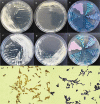Trichosporon dohaense, a rare pathogen of human invasive infections, and literature review
- PMID: 30288064
- PMCID: PMC6160283
- DOI: 10.2147/IDR.S174301
Trichosporon dohaense, a rare pathogen of human invasive infections, and literature review
Abstract
Background: Trichosporon dohaense is a rare fungal species that has not been described in human invasive infections.
Patients and methods: In this study, we investigated two T. dohaense isolates from patients with invasive infections in two hospitals in China, as part of the China Hospital Invasive Fungal Surveillance Net (CHIF-NET) program. Both patients were under immunocompromised conditions.
Results: On chromogenic agar, T. dohaense isolates were dark blue, similar to the color of Candida. tropicalis, but the characteristic moist colony appearance was quite different from that of T. asahii. The two isolates were misidentified as T. asahii and T. inkin by the VITEK 2 YST system. The rDNA internal transcribed spacer (ITS) region and the D1/D2 domain sequences of the two T. dohaense isolates were 100% identical to T. dohaense type strain CBS10761T. The sequence of the intergenic spacer region-1 also clearly distinguished the species. Of the three matrix-assisted laser desorption/ionization time-of-flight mass spectrometry systems, Bruker Biotyper and Autobio MS correctly identified the two isolates to species level, whereas Vitek MS systems misidentified them as T. ovoides or T. asteroides. Echinocandins exhibited no in vitro activities against the two T. dohaense isolates. In addition, the isolates exhibited intermediate susceptibility to fluconazole (with minimal inhibitory concentrations [MICs] of 8 and 16 µg/mL) and itraconazole, voriconazole, and posaconazole (MICs of 0.25-1 µg/mL). T. dohaense demonstrated susceptibility to amphotericin B with MIC of 1 µg/mL. The MICs of fluconazole and voriconazole in our study were higher than the MIC50 of 62 for T. asahii isolates (4 and 0.064 µg/mL) in the CHIF-NET program.
Conclusion: This case study points to a possible emergence of T. dohaense as an opportunistic human invasive fungal pathogen, and the reduced susceptibility should be noted.
Keywords: Trichosporon dohaense; emerging pathogen; identification; invasive infection; reduced susceptibility.
Conflict of interest statement
Disclosure The authors report no conflicts of interest in this work.
Figures



Similar articles
-
Invasive Infections Due to Trichosporon: Species Distribution, Genotyping, and Antifungal Susceptibilities from a Multicenter Study in China.J Clin Microbiol. 2019 Jan 30;57(2):e01505-18. doi: 10.1128/JCM.01505-18. Print 2019 Feb. J Clin Microbiol. 2019. PMID: 30463892 Free PMC article.
-
Molecular identification and susceptibility of Trichosporon species isolated from clinical specimens in Qatar: isolation of Trichosporon dohaense Taj-Aldeen, Meis & Boekhout sp. nov.J Clin Microbiol. 2009 Jun;47(6):1791-9. doi: 10.1128/JCM.02222-08. Epub 2009 Mar 25. J Clin Microbiol. 2009. PMID: 19321719 Free PMC article.
-
The development of animal infection models and antifungal efficacy assays against clinical isolates of Trichosporon asahii, T. asteroides and T. inkin.Virulence. 2015;6(5):476-86. doi: 10.1080/21505594.2015.1020273. Epub 2015 Mar 9. Virulence. 2015. PMID: 25751127 Free PMC article.
-
Candida and candidaemia. Susceptibility and epidemiology.Dan Med J. 2013 Nov;60(11):B4698. Dan Med J. 2013. PMID: 24192246 Review.
-
Molecular characterization and antifungal susceptibility testing of Candida nivariensis from blood samples - an Iranian multicentre study and a review of the literature.J Med Microbiol. 2019 May;68(5):770-777. doi: 10.1099/jmm.0.000963. Epub 2019 Mar 29. J Med Microbiol. 2019. PMID: 30924763 Review.
Cited by
-
COVID-19-associated brain abscess caused by Trichosporon dohaense: A case report and review of literature.Med Mycol Case Rep. 2022 Mar;35:9-14. doi: 10.1016/j.mmcr.2021.12.002. Epub 2021 Dec 16. Med Mycol Case Rep. 2022. PMID: 34931159 Free PMC article.
-
Invasive Infections Due to Trichosporon: Species Distribution, Genotyping, and Antifungal Susceptibilities from a Multicenter Study in China.J Clin Microbiol. 2019 Jan 30;57(2):e01505-18. doi: 10.1128/JCM.01505-18. Print 2019 Feb. J Clin Microbiol. 2019. PMID: 30463892 Free PMC article.
-
Comparison of Autof ms1000 and Bruker Biotyper MALDI-TOF MS Platforms for Routine Identification of Clinical Microorganisms.Biomed Res Int. 2021 Mar 3;2021:6667623. doi: 10.1155/2021/6667623. eCollection 2021. Biomed Res Int. 2021. PMID: 33763483 Free PMC article.
References
-
- Montoya AM, Sánchez González A, Palma-Nicolás JP, Gómez-Treviño A, González JG, González GM. Genotyping, extracellular compounds, and antifungal susceptibility testing of Trichosporon asahii isolated from Mexican patients. Med Mycol. 2015;53(5):505–511. - PubMed
LinkOut - more resources
Full Text Sources

